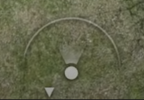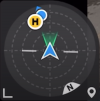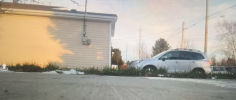Hi,I live in Northern Ontario, Canada, it gets cold here, presently -20c (-5f). Can I safely fly my Mavic Mini in cold weather, we get temperatures of -40c (-40f). Can the cold affect my drone ?
thank you.
thank you.
Thank you very much for such a good recommendation, I will surely follow these, and keeping the drone in sight is important to me since my compass is always 90 to 180 degree off, it’s awful for night time flying. Any explanation for this.As others have said, keeping your batteries warm prior to flight is very important. Don't insert them into the drone until you are ready to power on. I keep my batteries in my pockets or use a hand warmer. I'm not sure about the Mini, but I know that at cold temps my Sparks gimbal sticks - it looses its ability to pitch smoothly and automated functions like panos often fail or don't complete. I had it out the other day in -9ºC and was running an automated 360º pano and although the pano completed when I got home and assembled the pictures I noticed that the gimbal had not pitched all the way down so there were gaps in the pano. My other drone, a Phantom does not have problems in cold whether - I have had it out in temps as cold as -25ºC without any problems.
One thing that many people often overlook is your flying device. At temperatures of around -20ºC your device will not last long and may shut down abruptly without warning (I have had it happen to me) and unlike your Mini you cannot remove and replace the batteries with a warm one. Also at those temperatures the touch screen on your flying device becomes much less responsive or does not respond at all so be aware of this.
Some of the things that work for me:
•I keep my batteries in my pockets or use a battery warmer.
•I only insert my battery into my drone when everything else is set up.
•I use a hand warmer near my controller to keep it warm as it has a battery too
•I launch and hover for about a minute (check gimbal operation and battery temps)
•I don't use aggressive flight manoeuvres on very cold days, only gently ones.
•I use hand warmers in mittens. I just take them off briefly if I need to. At very cold temperatures, I rely on automated functions (Dronelink is amazing for this).
•I keep my flights short and usually land with about 40% battery left because usually by the end of the flight my hands have started to get cold and so this gives me more margin for getting the drone down before the battery gets too low.
•I keep the drone in VLOS at all times. This is especially important because if your flying device abruptly shuts down then you still have control of the drone and a way to get it back.
•I keep my iPhone in my pocket until I am ready to fly and immediately after a flight to keep its battery warm. Sometimes I will put it in my mitt with the hand warmer to warm it up.
•I make sure I am dressed for the cold. Even though I often hike, ski or snowshoe into and out of my flying locations, I know I will be standing around in the cold while flying.
Flying in cold winter weather offers opportunities to take beautiful photos/videos and get to places you can't get to in the spring/summer but it also adds layers of complexity to drone flying.
Hope this helps.
Chris
Thank youOne thing I would suggest before doing a real flight is do one long duration flight as low as possible over a soft landing place, jig back and forth etc. but stay close. Then check the state of the props. Plastics can become more brittle as the temperature drops.
At those temperatures is the air too dry for prop icing to be a concern?
If the soft landing place is snow check how the landing protection works over snow before jigging about etc..
When you say your compass is off, do you mean that the aircraft icon in the Fly app does not match the actual orientation the drone is facing? If this is the case it usually means you are launching in a magnetically compromised location. I would not be launching the drone like this as you risk having some erratic behaviour or even loosing control of the drone. Make sure there is no metal nearby. Often if you launch from a cement pad it will have rebar in it which will throw the compass off.Thank you very much for such a good recommendation, I will surely follow these, and keeping the drone in sight is important to me since my compass is always 90 to 180 degree off, it’s awful for night time flying. Any explanation for this.
...since my compass is always 90 to 180 degree off...
Guess the OP doesn't mean "the compass" ... as in the one in the craft. If it was he would have suffered the consequences a long time ago, yaw errors isn't something you can have "always" & get away with it....If this is the case it usually means you are launching in a magnetically compromised location.


The only indicator that I have is one the left bottom of the fly app, it shows a google map with a dot and arrow, the arrow is always off.When you say your compass is off, do you mean that the aircraft icon in the Fly app does not match the actual orientation the drone is facing? If this is the case it usually means you are launching in a magnetically compromised location. I would not be launching the drone like this as you risk having some erratic behaviour or even loosing control of the drone. Make sure there is no metal nearby. Often if you launch from a cement pad it will have rebar in it which will throw the compass off.
You could also post your logs to Flight Log Viewer and share the link back here and one of the experts like @Meta4, @slup, or @sar104 might be able to take a look at them and tell you why your compass is off so much.
Chris
This is what I have, thanksGuess the OP doesn't mean "the compass" ... as in the one in the craft. If it was he would have suffered the consequences a long time ago, yaw errors isn't something you can have "always" & get away with it.
Suspect he means the attitude indicator ... that's very often wrongly interpreted as the compass. If that doesn't show the correct direction it's due to that the mobile device compass is disturbed by the RC itself & will not affect the craft.
This one, mid bottom screen edge in the FLY app version up to 1.2.1
View attachment 139537
... or this one, left bottom corner from FLY app version 1.2.2 & onwards
View attachment 139538
If your drone has this right in front it ...This is what I have, thanks


If that indicator is always off, that is because the compass in your phone or tablet is being deflected by magnetic fields that are part of the controller or the phone or tablet itself.The only indicator that I have is one the left bottom of the fly app, it shows a google map with a dot and arrow, the arrow is always off.
I have a buddy who flew an Air (original) in -35° with no problems. his advice:Hi,I live in Northern Ontario, Canada, it gets cold here, presently -20c (-5f). Can I safely fly my Mavic Mini in cold weather, we get temperatures of -40c (-40f). Can the cold affect my drone ?
thank you.
That's not entirely correct ... he shows the map with the triangular drone icon. If the icon there is off comparing drone direction in reality & how the icon on the map points in relation to map objects ... it's a valid indication of a IMU heading direction that is not correct (possibly coming from a deflected AC compass at power on).If that indicator is always off, that is because the compass in your phone or tablet is being deflected by magnetic fields that are part of the controller or the phone or tablet itself.
It has nothing to do with the drone or its compass.
Recalibrating the compass in the phone or tablet while attached to the controller (powered on), might fix that.
I’m using a 2021 Samsung TabA sm-t307u,8inch tablet, there is no compass on this device and it does not support compass apps. Could this be the problem ?If that indicator is always off, that is because the compass in your phone or tablet is being deflected by magnetic fields that are part of the controller or the phone or tablet itself.
It has nothing to do with the drone or its compass.
Recalibrating the compass in the phone or tablet while attached to the controller (powered on), might fix that.


